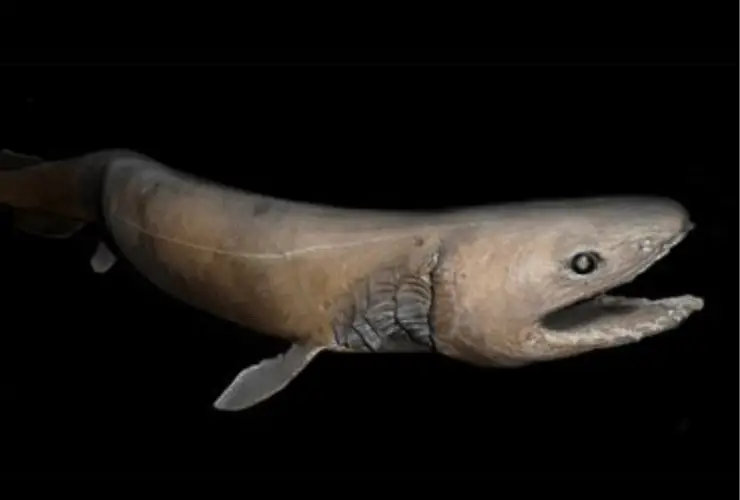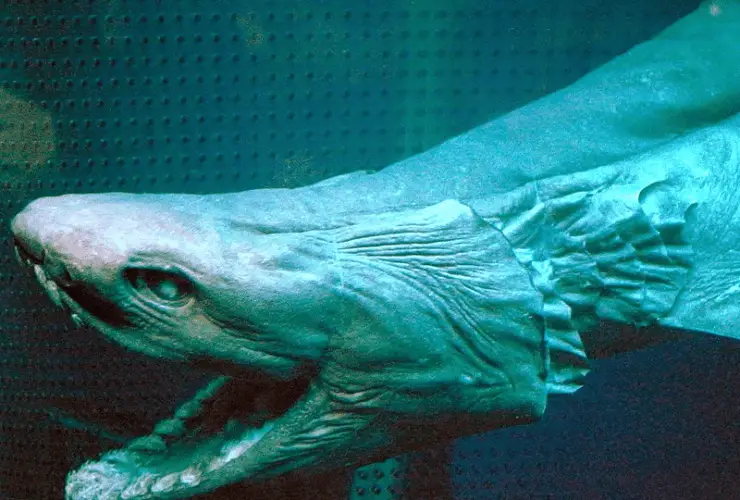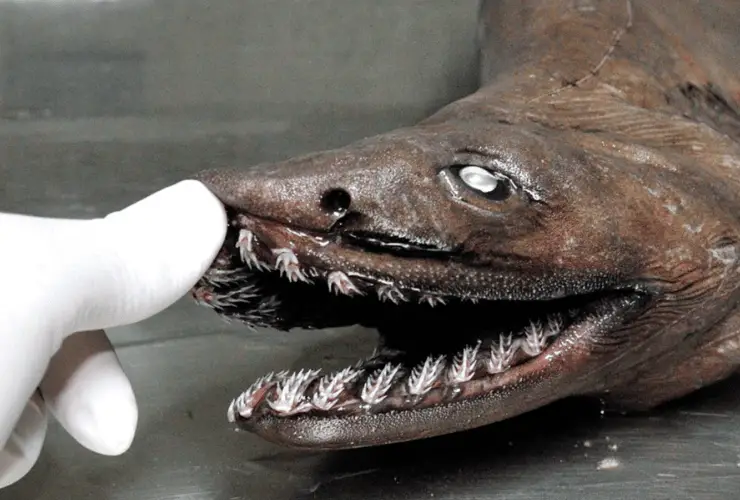There are numerous unknown frilled shark facts. Some of them are real, and some are just myths. For example, due to their eel-shaped body, people think they are eel fish, not sharks. Even some people ask when did frilled sharks go extinct, believing they are no longer existing. All these are false.
Neither frilled sharks are eel fish, nor they went extinct. They still exist, but there is a probability that they may go extinct due to several environmental factors and human activities.
These eel-like creatures, akin to sharks in many ways, are some of the rarest sea life found today. That’s the main reason people think they might go extinct.
In this article, I will disclose everything you should know about this mysterious creature, including all the relevant factors which may cause their extinction, including how we can save them.
About Frilled Sharks
| Feature | Description |
| Scientific Name | Chlamydoselachus anguineus |
| Common Name | Frilled Shark |
| Appearance | Eel-like body, dark brown or grey coloration, frilly gill slits |
| Size | Up to 2 meters (around 7 feet) in length |
| Habitat | Deep sea, typically found at depths between 500-1,500 meters |
| Range | Atlantic Ocean off the coasts of Norway, Scotland, Ireland, and Namibia; Eastern Pacific off California and Chile; West Pacific off Japan, Australia, and New Zealand |
| Diet | Squid and various fish, including other sharks |
| Reproduction | Ovoviviparous, with embryos developing inside the female’s uterus |
| Threats | Overfishing, habitat destruction, bycatch in deep-sea fisheries |
| Conservation Status | Near Threatened (IUCN Red List) |
Frilled sharks (Chlamydoselachus anguineus) are one of the oldest surviving species of shark, with fossil evidence suggesting they have been alive for more than 80 million years.
They stand out from the crowd thanks to their unusual length eel-like bodies, flattened heads, and wide mouths full of sharp fangs that may curve inward. Named for the six frilled gill slits that run the length of their bodies, these fish are easily identifiable.
Frilled sharks inhabit the shallower parts of the Atlantic and Pacific Oceans (500–1,500 m, though they have been discovered as deep as 1,800 m (5,900 ft) in the western Pacific. Fish, squid, and other sharks make up the majority of this species’ diet, and they can be found in locations with steep undersea canyons and seamounts where they hunt.
Frilled sharks have been around for a long time, but despite this, they are still mostly unknown to science. In 1884, German ichthyologist Ludwig H.P. Döderlein studied a specimen collected off the coast of Japan and wrote the first description of the species.

Fewer than a dozen live specimens have been caught since then, almost exclusively by deep-sea fishing trawlers or by chance while cleaning fish.
The degradation of their habitat, overfishing, and bycatch in fishing nets are only a few of the modern dangers to frilled sharks. The International Union for the Conservation of Nature (IUCN) classifies them as “near threatened,” and countries like Japan designate them as “national monuments” in order to preserve them.
The state of their population and the risks they face, as well as the development of efficient conservation methods to preserve this rare and ancient species for future generations, require much more study.
Anatomy of Frilled Sharks
Frilled sharks are a mysterious and interesting species with a unique look and body structure. Here’s what their bodies look like:
Head: A frilled shark’s head looks like that of a lizard. It has a blunt nose and a large mouth with many rows of sharp, three-pronged teeth. Even though each tooth is small, there are about 300 of them, giving the shark almost a thousand sharp hooks to catch prey that is trying to get away.
Gills: There are six-gill slits on each side of the body, behind the head. Each one has a unique frilly edge. The front slits on each side go down the body and meet under the throat, making it look like a collar with frills.
Body: A frilled shark’s body is in the shape of an eel and is dark brown or grey in colour. It has a large anal fin and small pectoral fins that look like paddles. The dorsal fin is small and far back on the back of the fish.
Caudal Fin: A frilled shark’s caudal fin has a small, dead lower lobe, while the upper lobe is very long, making the shark’s body even longer.
Teeth: Frilled sharks have teeth that are in multiple rows, and each tooth has three prongs. These teeth are made to hook onto the flesh of their prey and hold them in place while the shark eats them. New teeth grow in to replace the old ones as they fall out throughout a shark’s life.
Digestive System: Frilled sharks have a simple digestive system made up of a long, coiled intestine and a stomach that can grow to fit large prey. Like other sharks, they can throw up food they can’t digest.
Nervous System: Frilled sharks have a well-developed nervous system that helps them find food and get around. They have a big brain and an organ network that lets them feel things. These organs include electroreceptors that can pick up on other animals’ electrical fields.
Reproduction system: Ovoviviparous, like many other sharks, the frilled shark’s reproductive system involves the embryo developing inside the female’s uterus with the help of a yolk sac. Once the nutrients in the yolk sac are depleted, the embryos continue to get what they need from the uterine secretions until delivery.
Muscles: Frilled sharks have strong muscles that help them swim quickly and well. They also swim in a way that is different from other fish. Their long bodies move in an eel-like way as they swim.
Where Do Frilled Sharks Live?
The majority of frilled sharks’ habitats are found in the ocean’s deeper regions, specifically near the upper slopes and continental shelves. The Atlantic Ocean off the coasts of Norway, northern Scotland, western Ireland, and northern Namibia are all places where you can find them.
Moreover, they are present in the Eastern Pacific off Southern California and Northern Chile and in the West Pacific off South-East Japan, eastern Australia, and New Zealand.
Additional evidence implies that frilled sharks may be present in the Western Indian Ocean, off South Africa. The bulk of these species live at depths between 500 and 1,000 meters below the surface, yet some have been identified at lesser depths between 50 and 200 meters.
However, some of them may be found at depths of more than 1,500 meters. These depths are too far down for humans to explore, which is why these creatures remain so mysterious.
Although the frilled shark is most commonly seen in deep water, it has been known to swim far higher up in the water column and even occasionally near the ocean floor.
What Do Frilled Sharks Eat?
Frilled sharks are predators that primarily feed on squid and a variety of fish, including other sharks. Analysis of stomach contents of Frilled sharks brought to the surface indicates that they consume a wide range of deep water prey such as cephalopods, crustaceans and bony fish.
They have also been observed to feed on faster-swimming squid higher in the water column at depths between 50 and 200 meters.
The species’ set of needle-sharp, inwardly-pointing teeth and its ability to open its jaws extremely wide suggests that it may actively take prey over one and a half times its own length using an eel-like approach. This means that Frilled sharks can easily catch smaller prey by ambushing them from within their hiding places or chasing them down in open waters.
Furthermore, the presence of large eyes indicates that these creatures may also use vision to help them locate their prey.
So, it appears that Frilled sharks are predominantly piscivorous predators, although their diet may be more diverse than previously thought. They likely utilize a range of hunting strategies to capture their food sources depending on the circumstances in which they find themselves.
How Long Does a Frilled Shark Live?
The frilled shark is a species of eel-like shark that typically lives in deep waters. It is believed to have one of the longest lifespans among sharks, estimated at around 25 years.
A frilled shark is relatively small at birth, measuring around 11 inches (28 cm) in length. They can grow up to 6 feet (1.8 m) long as they reach maturity and age. In the wild, they tend to inhabit depths of between 820-4200 feet (250-1300 m) and live mainly on cephalopods such as squid, octopus, crabs and fish.
As a member of the order Chlamydoselachiformes, frilled sharks do not possess any major defence mechanism against predators such as large fish or marine mammals like seals and dolphins.
To compensate for their lack of physical protection from predators, frilled sharks rely heavily on their camouflage abilities and sense of smell to stay hidden from potential threats.
Frilled sharks are considered slow-growing animals due to their longevity; however, they will continue to mature until they reach an age over ten years old. During this period, they become more aggressive when defending their territory or searching for food sources like squid and other cephalopods.
As apex predators at the top of the underwater food chain, they have been known to feed on ungulates such as seals or even smaller fish species like cod and haddock if prey sources become scarce.
Do Frilled Sharks Still Exist?
Yes, frilled sharks still exist. However, people think they might go extinct. This particular species is one of the only surviving members of its family, which dates back 80 million years to the Cretaceous period.

The frilled shark can be found in various parts of the Atlantic and Pacific Oceans, although it primarily inhabits deeper waters up to 5,000 feet deep. They are considered “living fossils” due to their ancient ancestry and primitive features.
Frilled sharks typically grow up to 5-6 feet long and have an eel-like body with a characteristic frill around its neck composed of 6 gills. Even though they look scary, they are usually slow-moving creatures that eat smaller fish and squid.
They have also been known to attack larger prey, including deep sea sharks, by latching onto them with their sharp rows of teeth, which can reach up to 300 in number on each side.
Overall, frilled sharks remain a mysterious species as very few photos, and videos exist due to their deep water habitat making them difficult to study. But this enigmatic species continues to cling on in today’s oceans, giving us insight into what life looked like many millions of years ago.
When Was The Frilled Shark Found?
The frilled shark was first discovered in Japan in 1884 by a scientist named Ebert. This species of shark is rarely seen by humans, as they typically stay at depths of more than 1500 feet. However, sometimes, they are found at depths of 500-1000 feet.
Since the discovery of the first frilled shark in 1884, only one other known species has been found, which was discovered in 2009 and named the southern African frilled shark.
The new species was also discovered by Ebert and revealed some interesting physical differences from the original Japanese species.
How Many Species of Frilled Sharks Exist?
Currently, there are only two known species of frilled sharks: the frilled shark (Chlamydoselachus anguineus) and the recently discovered southern African frill shark (Chlamydoselachus africana).
The latter (Chlamydoselachus africana) was discovered in 2009 off the coasts of southern Angola, Namibia, and South Africa (discussed above).
What Is the Population of Frilled Sharks?
The population of frilled sharks is unknown, as they are rarely observed in their natural habitat. There have been a few observations of frilled shark populations and sightings, but the exact number remains uncertain.
The species has an ovoviviparous reproductive system and very small litter, with 2-15 offspring per litter. Studies on frilled shark embryos suggest that the species may have a gestation period lasting more than 3.5 years, which would make it one of the longest-known among vertebrate species.
Due to their low reproduction rate and difficulty of observation, the population of frilled sharks is likely declining due to overfishing and other human activities.
Although some conservation efforts are being made in various parts of the world, much research must be done to properly assess the current state of frilled shark populations and take necessary steps for their protection.
Why May Frilled Sharks Go Extinct?
The frilled shark may be in danger of extinction for a variety of reasons. One of the main causes is human activity, such as overfishing and habitat destruction. Overfishing is a major problem for the frilled shark, as it has been caught accidentally in certain fisheries as bycatch.
Without active fishery management to reduce the accidental catch of this species, their population can continue to decline.
In addition, habitat destruction due to development or climate change can also put them at risk, as it reduces their chances of finding food and suitable places to reproduce.
Environmental factors may also contribute to the decline of the frilled shark population. Changes in ocean temperature can disrupt the shark’s life cycle and interfere with its ability to find food.
Additionally, since these sharks are typically found at great depths, they are more susceptible to pressure changes, making it difficult for them to survive. As they grow slowly and have few offspring compared with other species of sharks, they also have a harder time adapting and recovering from environmental changes like these.
Finally, pollution – both on land and in the ocean – can create hazardous conditions for the frilled shark because pollutants such as heavy metals settle into deep ocean sediments, where this species spends much of its time. These pollutants can then accumulate in their tissues and cause further harm to their health and reproductive capabilities.
Overall, human activities and environmental factors threaten the survival of frilled sharks and could lead them to extinction if not addressed through active management efforts soon.
Is There Any Conservation For Frilled Sharks?
The frilled shark faces considerable threats to its survival, yet various conservation efforts are being carried out to preserve it. Currently classified as ‘Least Concern’ on the IUCN Red List, these initiatives aim to keep this stunning species from becoming endangered or worse.
Also, fishing fleets have taken steps in Japan and Australia to reduce their bycatch of this species. In addition, certain ocean areas have been designated as protected marine reserves for sharks.
In these places, there are restrictions on fishing and other commercial activities, which help to ensure the health of frilled shark populations.
Furthermore, research organizations such as WWF are working with governments around the world to implement policies that protect this species and its habitat.
Finally, education campaigns have been developed in order to spread awareness about the importance of preserving this unique species and keeping it from going extinct.
With the combined efforts of researchers, governments, and the general public, there is hope that the frilled shark can be saved from extinction. However, it is still important to continue taking steps to protect this species and its environment to ensure its long-term survival.
Mythical Question about Frilled Sharks (One-Line Answer):
Is frilled shark snake or eel?
A frilled shark is neither a sea-snake nor an eel-fish.
Are frilled sharks poisonous?
No, frilled sharks are not poisonous.
Are frilled sharks species of dinosaurs?
No, frilled sharks are not dinosaurs, but as living fossils, they have been existing on this earth since the dinosaurs’ period.
Are frilled sharks dangerous for humans?
Scientists have reported small bites from frilled sharks, but they are not dangerous for humans.
Are frilled sharks blind?
No, frilled sharks are not blind.
When did frilled sharks go extinct?
Frilled sharks didn’t go extinct, however, they are still existing.
Conclusion
So, now you have a compact knowledge of frilled sharks. Remember, although frilled sharks didn’t go extinct yet, they still face serious threats in the future. Various conservation efforts are being made to preserve this species, but more needs to be done to ensure its safety and longevity.
Therefore, we must do our part by supporting these initiatives and taking necessary measures for their protection.
Image Source: wikipedia.org


3 thoughts on “Frilled Shark Facts: Do They Exist Now?”